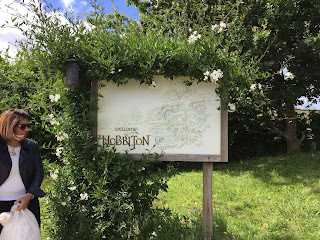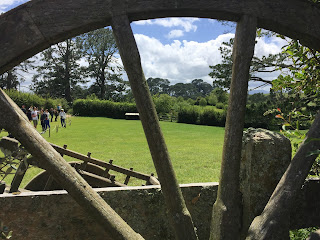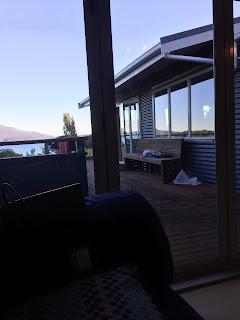Hobbitses, Glow Worms & T-Shirts, Oh My! (Plus, the Milky Way)
Aside from hanging with family, we had a couple things we really wanted to squeeze in to our time in Rotorua: Hobbiton and the Waitomo Glow Worm Caves. Ned booked a package tour with a driver who would zip us (well, zipping is a relative term in NZ) from the house to Waikato for Hobbiton and then to Waitomo for the caves. All told, we'd be on the road and touring from about 8:30 am to 6 pm.
Our driver to Hobbiton was Fran--who had some very definite ideas about migration into NZ that were balanced with a wide-ranging sense of NZ history and geography and solid recommendations on ice cream. So, six of one, half a dozen of the other. On the drive, we were struck by the beauty and variety of the countryside. For a few kilometers, we'd be surrounded by mounds in the earth that served as pressure release valves for the region's volcanic activity; then, rolling farmlands with hundreds of sheep or cattle; then, acres of corn; then, small suburbs; then, dams that supplied the country's hydro power; then, horse paddocks; then, Maori settlements; then, vistas that seemed to go for a hundred miles, revealing green fields backed by soft hills backed by volcanic mountains backed by lakes. All this in a journey of about 55 winding miles. NZ is like all of nature boiled down to its essence so every possible terrain, geography, topography, and formation could fit into a very small space: moonscape, mountain, volcano, glacier. fields, gorge, cave, river, lake, bay, rainforest, fjordland, valley ... yes, please and more if you've got them.




Check out this example: it's from the Alexander Farm. The Alexanders farm 1500 acres of sheep and cattle; they turned over a couple hundred to Peter Jackson for Lord of the Rings and the Hobbit. They own everything you see, and all that you see below (beyond the lake and the hobbit houses) is real. It's what drew them--the hills, the trees, the mountains. Real NZ.

Fran shared that pre-settled NZ was so thick with brush, ferns, and trees that it had no grass. It also had no mammals, only birds. From pigs to sheep to horses to (mistakenly) possums (which have taken over the nation and are destroying wild life and tree cover) to cattle and more were all imported. All of the gorgeous farmland that fills the countryside was originally cleared by hand. Anything can grow in NZ--which is one reason why the country has super strict bio-hazard laws that require everyone to declare anything that might impact this ecosystem from hiking boots that might be carrying organisms in their muddiness to any food, including prepackaged snacks.
We were delighted to have a driver because the weirdest thing about NZ driving isn't that they drive on the other side of the road, it's that the country (outside of Auckland) is so sparsely populated that the roads are almost empty. No traffic also means no stops: I can count on one hand the stop signs and stop lights (together) we've seen in this region. Driving through NZ is like driving through the seemingly abandoned backroads of Upstate NY but with about half as many cars. This seems to be one reason why NZ has some very nasty tourism-related accidents: unlike in America, where one can just figure out the traffic patterns by following a "native," there may not be any other drivers on the road for kilometers. By the time one figures out, "Damn, I'm supposed to be driving on the left," the accident has already happened.
After about 75 minutes, we pulled into Hobbiton. The short history is this: the Alexander farm was the set for the Hobbits-y portions of LOTR. After those movies, all the sets were demolished. Then, when it came time to film the Hobbit movies, Farmer Alexander had a different conversation with Director Jackson: hey, let's build these sets to last and make a tourist attraction. Sounds like a plan, said Jackson. And, ta-da, Hobbiton was born. Essentially, the entire experience, which draws hundreds of thousands of visitors a year is this: get on a bus, watch a couple movie clips, get off the bus, walk around meticulously maintained Hobbit holes of various scales, and be wowed at the cuteness and beauty that surrounds you. That's it. And, given that the day we went was exceedingly lovely--brightest of blue skies and just enough warmth to remind you it's summerlike--we were happier than ever expected to wander up hill and down admiring the world of Hobbitses. Some photos:









Seriously, how cute is this stuff!?! Little houses with colorful doors, benches, mailboxes, and tiny remnants of the "jobs" of their occupants--plus little gardens, gorgeous gardens. I probably have over a hundred photos of these pretend homes, their chimneys and yards, their walkways and windows.






We were delighted to follow in the footsteps of Hobbits, past the home of Bilbo Baggins all the way to the Green Dragon Inn.



That tree is one of the few "not real" things: made with over 200K individually applied leaves, it was made to the the "younger" version of the actual tree that stood there. The latter was used in LOTR, Jackson felt it needed to be smaller for the Hobbit to show that this film series chronologically came first in the narrative. Ah, show biz.






Once inside, we got free "only in Hobbiton" beverages served in stoneware mugs in a highly detailed version of the Green Dragon, complete with three real fireplaces roaring with real fires.


Again, the little details were charmingly perfect ...



After the tour, we had lunch: a not-at-all Hobbits-y buffet in a warm-toned tent. I loved the decor; Ned said it made him a bit sick; the kids didn't care--they were just happy in their sibling hilarity. The food was passable and plentiful.




After lunch, Fran appeared to drive us to Waitomo. Because Hobbiton is a working farm, there's a series of gates that must be opened and then closed. Penn was happy to handle this chore. What you don't see is that a helicopter had landed right next to us. According to Fran, this is the travel choice of the very-well-to-do (often Russians): it takes just 25 minutes from Auckland to Hobbiton by chopper. These mystery guests also had their own exclusive Hobbiton bus. Oh-la-la :)



After a morning in the sun and then a filling lunch, we had a drowsy ride to Waitomo. Both of these signs grace the ticket center for the caves and in them is a story. Gradually, all native lands are being returned to the Maori. The caves will return at the end of the current lease--about 2027, meaning a shift toward the traditional Maori appearance of its surroundings. As our guide--herself Maori--shared, "Expect to see a lot more brown faces in 2027."


Maori warrior tongues

Much as we discovered this summer at Mammoth Cave, tourists have been visiting Waitomo for about 100 years, and their dress in the past bore no resemblance to our sneakers and ball caps:

There are no photos allowed in the caves nor on the boat ride through the glow worms, so the photos below are from the interwebs and give you an idea of the impressive and a bit scary limestone caves and the beautiful (but murderous) display of the glow worms. NZ is in a peak earthquake zone, so being underground around a ton of stalactites can test one's nerves. The guide pointed out where the limestone had shifted and even fell over time. Still, it was gorgeous--and apparently, if one drips on you, it's good luck. Drips all around!

The cave starlight provided by the glow worms is really a trick of nature designed to lure their prey up from the river and into the almost invisible long strands that capture them for dinner.

These strands line the "roof" of the caves, especially over the water, and
sparkle with bioluminescence. Looking up as we slowly sailed through the caves, we saw tens of thousands points of
blue glowing light which reflected off the water. The stalactites added to the atmosphere: in the darkness, they sometimes masked and then suddenly revealed the cave "sky." It was unlike
anything we had ever experienced. Just super cool!


We did get to take photos after exiting the cave into a real-life Jurassic Park of ferns and trees. Ned declared it the year of the cave since we had managed to climb through the world's longest and one of the most lovely.


After Waitomo, we switched up drivers: trading Fran for Dave so that she could get back to Auckland and Dave, a Rotorua resident, could get home. Dave shared more NZ Facts and more thoughts about recent migrants to the nation. (So many feels about Asian drivers and rising property prices.) Another winding drive through lovely NZ brought us back to the house with enough time to rest a bit before Christmas Eve dinner.


After some spaghetti, we engaged in one of the traditions of our NZ family: the annual wearing of Christmas t-shirts. Who knew? Shenanigan-filled pictures were had by all.







After all the photos were done and the littlest cousins were fast asleep waiting for Santa, I wandered out on the porch to check out the Christmas Eve sky. Much is made of the star watching in NZ. Would it hold up to the hype. Well ... the entire sky shone with stars, including a visible Milky Way and more than a few of the "shooting" variety. From our temporary home we could see the dark profile of sleeping giant Mount Terawara etched against a sky vibrating with twinkling white pinpoints and sharpie pen-points of light. One by one, more of us came out onto the porch in the chilly Rotorua night, wearing quickly thrown on coats and random shoes found on their path to the doors ... the voice of Neil DeGrasse Tyson in our heads and visions of planetarium visits past filling our eyes. We tried in vain to take photos--until we realized that some things should just be experienced and shared with wonder. Thank you, NZ, you brought the stars within our grasp and made us spin like dervishes trying to catch these celestial gifts. Happy Christmas Eve!



Comments
Post a Comment